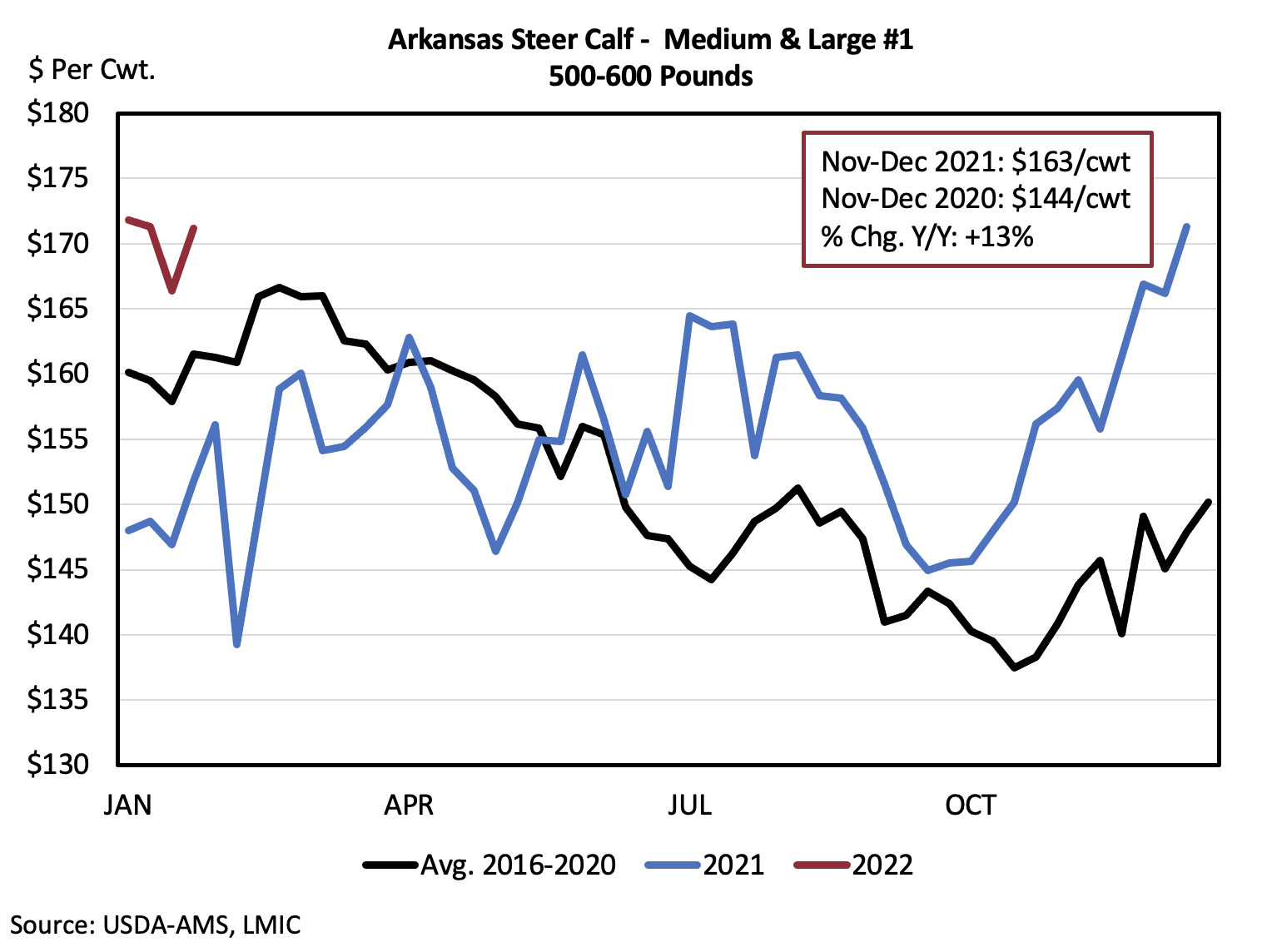Feb. 11, 2022
January Cattle Inventory Report shows tighter supplies, bullish market for Arkansas
By the U of A System Division of Agriculture
Fast Facts:
- Arkansas cattle herds decline more than 5 percent from 2021
- Smaller calf numbers mean tighter beef supply in 2022-2023
- Herds declined 2 percent nationally
(602 words)
(Newsrooms: With graphics at https://flic.kr/p/2n388GA and https://flic.kr/p/2n34QRD)
LITTLE ROCK — Arkansas cattle inventories declined for the third straight year, falling more than 5 percent from January 2021 estimates, liquidating about 90,000 cattle and calves, according to the January Cattle Inventory Report from the U.S. Department of Agriculture.
The state’s 5 percent drop more than doubles that of the national cattle inventory, which is 2 percent less than January 2021 estimates.
James Mitchell, extension agricultural economist for the University of Arkansas System Division of Agriculture, said opinions vary throughout the agricultural industry, as far as whether the state is likely to see further liquidation of cattle holdings, or if a “levelling off” is at hand.
“USDA’s Cattle Inventory Report provides us with the most detailed data we will get all year on past and current cattle numbers in the United States and Arkansas,” Mitchell said. “Several estimates in the report are indicators for what to expect this year regarding supplies and prices.
“Several people question whether we will observe a period of sharp liquidation or more of a flattening of cattle inventories for the current cattle cycle,” he said. “This year’s report confirms that we are experiencing liquidation period, both in Arkansas and Nationally.”
Both beef cows and replacement heifers declined. Nationally, the beef cow herd fell 2.3 percent, which exceeded industry expectations. Heifers declined by 3.3 percent nationally. In Arkansas, beef cow herds declined only 2 percent, but heifers fell by 5 percent.
“Slaughter totals support these estimates,” Mitchell said. “In 2021, beef cow slaughter averaged 9 percent higher year over year, implying an 11.5 percent culling rate—the highest cull rate since 2011. Heifer slaughter averaged 4 percent higher in 2021.”
Looking ahead, the 2021 calf crop augurs a tighter beef supply for production in 2022-2023. In Arkansas, the 2021 calf crop was 2.5 percent smaller — more than double the 1.2 percent decline seen nationally. Based on these estimates, Mitchell and other economists forecast 2.8 percent and 2.1 percent declines in 2022 and 2023 beef production, respectively.
“If the drought persists in the Southern Plains and cow and heifer slaughter remains high, we could see a slight upward revision in beef production forecasts,” Mitchell noted.
More than meets the eye
But the typical industry indicators — beef cow liquidation, less heifer retention
and a smaller calf crop — don’t explain Arkansas' 90,000 head decline in cattle inventories,
Mitchell said.
“The most significant contributor for Arkansas was the decline in feeder cattle supplies outside feedlots,” he said. “USDA does not report feeder cattle supplies in the Cattle Inventory Report. Instead, we calculate it from other categories.”
Mitchell said feeder cattle supplies are more accurately calculated by adding other heifers, steers weighing 500 pounds or more and calves weighing 500 pounds or less.
“Subtract cattle on feed inventory, and you have an estimate for feeder cattle supplies outside of feedlots,” he said. “In Arkansas, feeder cattle supplies declined 57,000 head or 9 percent. The decline in feeder cattle accounts for 63 percent of the total Arkansas cattle inventory decline.
“Limited hay supplies and expensive feed probably limited winter feeding opportunities for some producers,” Mitchell said. “Add strong fourth-quarter feeder cattle prices in Arkansas — together, these factors led to producers selling some feeder cattle this fall that they would have otherwise held through the winter.”
Good news for producers
Mitchell described the overall tone of the Cattle Inventory Report as “bullish.”
“In Arkansas, a smaller 2021 calf crop and tighter feeder cattle supplies will support feeder cattle prices this spring and beyond,” he said. “We have the prices to be profitable this year. Forage availability and input costs will be critical factors to manage.”
To learn about extension programs in Arkansas, contact your local Cooperative Extension Service agent or visit www.uaex.uada.edu. Follow us on Twitter and Instagram at @AR_Extension. To learn more about Division of Agriculture research, visit the Arkansas Agricultural Experiment Station website: https://aaes.uark.edu. Follow on Twitter at @ArkAgResearch. To learn more about the Division of Agriculture, visit https://uada.edu/. Follow us on Twitter at @AgInArk.
About the Division of Agriculture
The University of Arkansas System Division of Agriculture’s mission is to strengthen agriculture, communities, and families by connecting trusted research to the adoption of best practices. Through the Agricultural Experiment Station and the Cooperative Extension Service, the Division of Agriculture conducts research and extension work within the nation’s historic land grant education system.
The Division of Agriculture is one of 20 entities within the University of Arkansas System. It has offices in all 75 counties in Arkansas and faculty on five system campuses.
Pursuant to 7 CFR § 15.3, the University of Arkansas System Division of Agriculture offers all its Extension and Research programs and services (including employment) without regard to race, color, sex, national origin, religion, age, disability, marital or veteran status, genetic information, sexual preference, pregnancy or any other legally protected status, and is an equal opportunity institution.
# # #
Media contact:
Ryan McGeeney
Communications Services
University of Arkansas System Division of Agriculture
Cooperative Extension Service
(501) 671-2120
rmcgeeney@uada.edu
